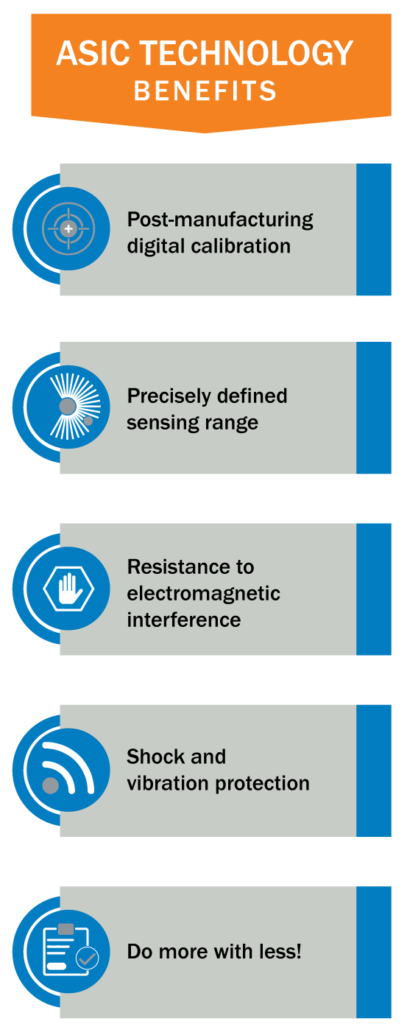The Benefits of an Inductive Proximity Sensor with ASIC Technology
 A carton of milk, a can of soda, and a squeeze tube of…mayonnaise? What do these three items have in common? Other than being items on your grocery list, all three may have been packaged with the use of an inductive proximity sensor, an ideal sensor for many aspects of food and beverage packaging.
A carton of milk, a can of soda, and a squeeze tube of…mayonnaise? What do these three items have in common? Other than being items on your grocery list, all three may have been packaged with the use of an inductive proximity sensor, an ideal sensor for many aspects of food and beverage packaging.
Although inductive proximity sensors share the same operating principle, not all are alike. A proprietary Application Specific Integrated Circuit (ASIC) makes all the difference. An ASIC is a customized integrated circuit that is designed specifically for an application.
With the unique functionality of SICK’s advanced ASIC technology, inductive proximity sensors for machine packaging operations benefit from:
- Post-manufacturing digital calibration that eliminates uncertainty
- Precisely defined, reliable, and repeatable sensing range which ensures consistent detection
- Enhanced resistance to electromagnetic interference, increasing reliability tenfold
- Pliable filling that protects against shock, vibration, and temperature extremes, and
- A simplified device—so you can do more with less!
Putting Inductive Proximity Sensors to Work – Top Applications
A SICK inductive proximity sensor with our proprietary ASIC technology can be applied to a variety of packaging system design and operation needs. Here are our top 5:
1. Position Detection on a Mechanical Moving Part
The process of inserting items into packages or cartons using metal flags fitted on conveyor chains is relatively simple. At the same time, it is also an extremely precision-driven function. The responsiveness and reliable detection qualities of inductive proximity sensors ensures consistent alignment and follow-through functions. That results in less waste and fewer system interruptions.
2. Gear Tooth Detection for Motion Monitoring
Reliable, repeatable results are also critical when monitoring the position of chain guides or flexors, which drives other components of conveyor system. With SICK’s ASIC chip technology, a packager can be assured that inductive proximity sensor’s high repeatability mitigate these variations. This ultimately produces more consistent and synchronized detection.
3. Valve Position Control during Processing
Most high-hygienic processes such as dairy or yogurt production utilize valves to switch system feeds from ingredients to cleaning solutions, then back when sanitation process is complete. Because a well-manufactured inductive proximity sensor is more resistant to wear than mechanical limit switches, processors have greater assurance of long-term, consistent valve operation.
4. Foil Seal Detection Inside Plastic Caps
Is a cap’s foil seal there, or isn’t it? With a wider range of foil seal material now being used, certain colors and textures may be missed by photoelectric sensors. This can result in false readings. Because an inductive proximity sensor looks merely for the presence of metal, the seal material’s qualities are irrelevant.
 5. Can Position Detection on a Beverage Line
5. Can Position Detection on a Beverage Line
The metal detection qualities of a SICK inductive proximity sensor with advanced ASIC technology are valuable on packaging lines for beverages and canned products. The reliability of the ASIC sensor’s programmed range, and the highest repeatability allows machine builders to incorporate a consistent space between the sensor and its targets. This prevents potential damage while preserving seamless operation.
Making Sound Detection Decisions
These are just some of the many ways inductive proximity sensors with custom ASIC technology from SICK benefit a packaging or process operation involving close-proximity metal targets.
Download the full whitepaper: Top 5 Applications for Inductive Sensors on Packaging Machines





